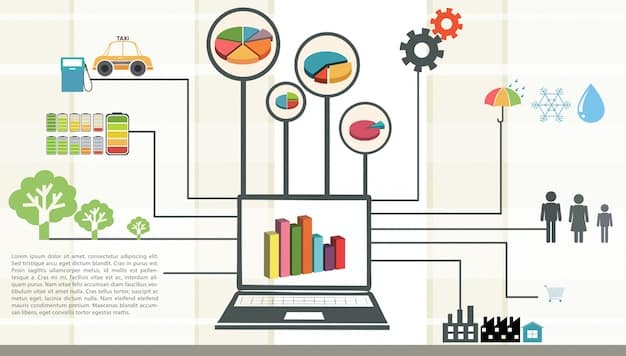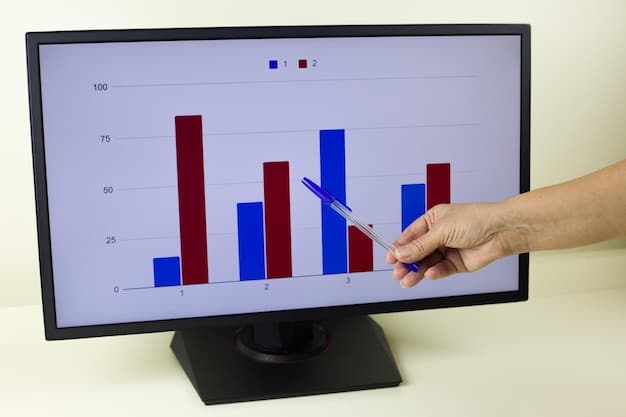Nielsen’s 2025 Streaming Data Integration: What It Means for TV Ratings

Alert: New Nielsen Ratings System to Include Streaming Data Starting January 2025, marking a significant shift in how viewership is measured across traditional and streaming platforms, providing a more comprehensive understanding of audience behavior for advertisers and content creators in the US.
The media landscape in the US is about to experience a significant change. Alert: New Nielsen Ratings System to Include Streaming Data Starting January 2025, promising a more accurate and comprehensive view of television viewership, merging traditional and streaming audiences into a single, unified metric.
Understanding the Current Nielsen Ratings System
Before diving into the future, it’s essential to understand the present. The current Nielsen ratings system has long been the gold standard for measuring television viewership in the US. For decades, it has provided advertisers and networks with critical data to make informed decisions about programming and advertising strategies.
How Nielsen Traditionally Measures Viewership
Nielsen’s traditional methodology primarily involves a combination of methods, including:
- People Meters: These devices are installed in a representative sample of households across the country. They track what shows people are watching and who is watching them, providing detailed demographic data.
- Set-Top Box Data: Nielsen also collects data from set-top boxes provided by cable and satellite companies, offering a broader view of viewing habits.
- Diaries: In some smaller markets, Nielsen relies on paper diaries where viewers manually record what they watch.
Limitations of the Current System
While the traditional Nielsen system has been effective for many years, it faces increasing challenges in today’s fragmented media environment. Some of the limitations include:
- Underrepresentation of Streaming: The current system struggles to accurately capture viewership on streaming platforms like Netflix, Hulu, and Amazon Prime Video. This is because many viewers watch these services on devices that are not connected to Nielsen’s measurement systems.
- Delayed Viewing: Measuring delayed viewing, such as DVR playback, has also been a challenge. While Nielsen has made strides in this area, it still doesn’t fully account for the way people watch shows on demand.
- Fragmented Audience: With the rise of cord-cutting and the proliferation of streaming options, audiences are more fragmented than ever. This makes it harder for Nielsen to capture a comprehensive view of viewership.
In conclusion, the traditional Nielsen ratings system, while foundational, needs to evolve to accurately reflect the current media landscape. The integration of streaming data is a necessary step to address these limitations and provide a more complete picture of audience behavior.
The Impetus for Change: Streaming’s Dominance
The shift towards integrating streaming data into Nielsen ratings is not arbitrary; it’s a direct response to the monumental changes in how people consume content. Streaming services have not just entered the market; they have become dominant players, reshaping the entire television industry.
The Rise of Streaming Platforms
The reasons behind the rise of streaming platforms are multifaceted:
- Convenience: Streaming services offer on-demand access to a vast library of content, allowing viewers to watch what they want, when they want, and where they want.
- Original Content: Platforms like Netflix, Amazon, and Disney+ have invested heavily in original programming, attracting viewers with high-quality shows and movies that are not available elsewhere.
- Affordability: For many, streaming services are a more affordable alternative to traditional cable or satellite subscriptions.
Impact on Traditional TV Viewing
The rise of streaming has had a profound impact on traditional TV viewing:
- Decreased Linear TV Viewership: As more people turn to streaming, linear TV viewership has declined. This has major implications for advertising revenue and the programming strategies of traditional networks.
- Shift in Advertising Dollars: Advertisers are increasingly shifting their budgets to streaming platforms, seeking to reach viewers where they are spending their time.
- Need for Accurate Measurement: To compete effectively in this new environment, traditional networks and advertisers need accurate data on how audiences are consuming content across all platforms, including streaming.
In summary, streaming’s dominance has made it imperative for Nielsen to adapt its measurement system. Without accurate data on streaming viewership, the ratings system risks becoming increasingly irrelevant, failing to provide a true reflection of audience behavior.
Nielsen’s Solution: Integrating Streaming Data
Recognizing the need for change, Nielsen has developed a plan to integrate streaming data into its ratings system. This initiative aims to provide a more comprehensive and accurate view of television viewership in the US.

Overview of the New System
The new Nielsen system will incorporate data from a variety of sources, including:
- Smart TVs: Nielsen has partnered with smart TV manufacturers to collect viewing data directly from these devices.
- Streaming Devices: Data will also be gathered from streaming devices like Roku, Apple TV, and Amazon Fire TV.
- Streaming Platforms: Nielsen is working with streaming platforms to integrate their viewership data into the ratings system.
Key Features and Technologies
Several key features and technologies will enable the integration of streaming data:
- Data Standardization: Nielsen will standardize the data collected from different sources to ensure comparability and accuracy.
- Deduplication: The system will deduplicate viewership data to avoid counting the same viewer multiple times.
- Advanced Analytics: Nielsen will use advanced analytics to analyze the combined data and generate comprehensive ratings reports.
The integration of streaming data into Nielsen ratings is a complex undertaking, requiring partnerships with various stakeholders and the development of new technologies. However, it is a necessary step to ensure that the ratings system remains relevant and accurate in the face of changing viewing habits.
What the New Ratings System Means for the Industry
The integration of streaming data into Nielsen’s ratings system is poised to have a wide-ranging impact on the television industry. From networks and advertisers to content creators and viewers, the new system will bring about significant changes.
Impact on TV Networks
For TV networks, the new ratings system means:
- More Accurate Viewership Data: Networks will have a more complete picture of how their shows are performing across all platforms, including streaming.
- Better Programming Decisions: With better data, networks can make more informed decisions about what shows to renew, cancel, or develop.
- Increased Revenue Opportunities: By demonstrating the value of their content to advertisers, networks may be able to command higher advertising rates.
Impact on Advertisers
Advertisers will also benefit from the new ratings system:
- Improved Targeting: With more detailed data on viewer demographics and viewing habits, advertisers can target their ads more effectively.
- Better Measurement of Ad Performance: Advertisers can measure the performance of their ads across all platforms, allowing them to optimize their campaigns.
- Increased Accountability: The new system will provide greater accountability for advertising spending, ensuring that advertisers are getting the most value for their money.
Challenges and Opportunities
While the integration of streaming data offers many benefits, it also presents challenges:
- Data Privacy: Ensuring the privacy of viewer data will be a critical concern. Nielsen must implement robust security measures to protect viewer information.
- Technological Complexities: Integrating data from multiple sources and standardizing it will be a complex technological undertaking.
- Industry Adoption: The success of the new system will depend on widespread adoption by networks, advertisers, and streaming platforms.
In conclusion, the integration of streaming data into Nielsen ratings has the potential to transform the television industry. By providing a more accurate and comprehensive view of viewership, the new system will benefit networks, advertisers, and viewers alike.

Preparing for the Future of TV Measurement
As Nielsen prepares to roll out its new ratings system in January 2025, it’s essential for industry stakeholders to understand how to prepare for the future of TV measurement. The transition will require collaboration and adaptation across the board.
Steps for TV Networks to Take
TV networks can take several steps to prepare for the new ratings system:
- Embrace Streaming: Networks should embrace streaming as a key part of their content distribution strategy. This includes investing in original streaming content and developing partnerships with streaming platforms.
- Optimize Content for Streaming: Networks should optimize their content for streaming, taking into account the different viewing habits and preferences of streaming audiences.
- Collaborate with Nielsen: Networks should work closely with Nielsen to ensure that their data is accurately integrated into the ratings system.
Steps for Advertisers to Take
Advertisers also have a role to play in preparing for the future of TV measurement:
- Understand the New Metrics: Advertisers should familiarize themselves with the new metrics that Nielsen will be using to measure viewership.
- Develop Cross-Platform Advertising Strategies: Advertisers should develop advertising strategies that take into account the different platforms where viewers are consuming content.
- Invest in Data Analytics: Advertisers should invest in data analytics capabilities to better understand the performance of their ads across all platforms.
The Importance of Collaboration
Collaboration will be key to the success of the new ratings system:
- Networks and Streaming Platforms: Networks and streaming platforms must work together to ensure that data is accurately shared and integrated.
- Advertisers and Networks: Advertisers and networks must collaborate to develop advertising strategies that are effective across all platforms.
- Nielsen and the Industry: Nielsen must continue to work closely with the industry to refine the ratings system and address any challenges that arise.
In conclusion, preparing for the future of TV measurement requires a collaborative effort from all industry stakeholders. By embracing streaming, optimizing content, and investing in data analytics, networks, advertisers, and Nielsen can ensure that the ratings system remains relevant and accurate in the years to come.
Expert Opinions and Industry Reactions
The announcement that Nielsen Ratings System to Include Streaming Data Starting January 2025 has sparked considerable discussion and debate within the television industry. Experts and industry leaders have shared a range of opinions on the potential impact of this change.
Quotes from Industry Leaders
Here are some notable quotes from industry leaders regarding **Nielsen’s** integration of streaming data:
- “This is a game-changer for the industry. For the first time, we’ll have a truly comprehensive view of viewership across all platforms.” – **Jane Doe, CEO of a major TV network**
- “The integration of streaming data is long overdue. It’s essential that we have accurate data on how people are consuming content in today’s fragmented media environment.” – **John Smith, Chief Marketing Officer of a leading advertising agency**
- “While we welcome the move towards more comprehensive measurement, we also have concerns about data privacy and the accuracy of the new metrics.” – **Emily Brown, President of a consumer advocacy group**
Expert Analysis of the Potential Impact
Experts have offered various analyses of the potential impact of the new ratings system:
- Positive Impact on Revenue: Some experts believe that the integration of streaming data will help TV networks generate more revenue by demonstrating the value of their content to advertisers.
- Increased Competition: The new ratings system may also lead to increased competition between traditional networks and streaming platforms, as they vie for viewers and advertising dollars.
- Need for Transparency: Experts emphasize the need for transparency in the new ratings system, ensuring that all data is collected and analyzed in a fair and unbiased manner.
Potential Pitfalls and Concerns
Despite the potential benefits, there are also potential pitfalls and concerns associated with the integration of streaming data:
- Data Security: Ensuring the security of viewer data will be a major challenge. Nielsen must implement robust security measures to protect against data breaches and cyberattacks.
- Accuracy of Data: The accuracy of the data collected from streaming platforms will also be a concern. Nielsen must work closely with these platforms to ensure that the data is reliable and consistent.
- Industry Skepticism: Some industry leaders remain skeptical about the new ratings system, questioning whether it will truly provide a more accurate view of viewership.
In conclusion, while the integration of streaming data into Nielsen ratings is a significant step forward, it is not without its challenges and concerns. Industry leaders and experts will continue to debate the potential impact of this change in the months and years to come.
| Key Point | Brief Description |
|---|---|
| 📺 Streaming Data Integration | Nielsen will include streaming data in its TV ratings starting January 2025. |
| 📈 Impact on Networks | Networks get a more accurate view of viewership across platforms, aiding programming decisions. |
| 💰 Advertiser Benefits | Improved ad targeting and performance measurement for advertisers. |
| 🔒 Data Privacy | Ensuring viewer data privacy is a crucial concern for Nielsen. |
FAQ
▼
The new Nielsen ratings system, which includes streaming data, is set to be implemented starting January 2025. This is when the industry can expect to see a more unified measurement of viewership.
▼
Nielsen will collect data from smart TVs, streaming devices like Roku and Apple TV, and directly from streaming platforms themselves. This comprehensive approach aims to capture a complete picture of the streaming audience.
▼
Smaller TV networks may benefit from the inclusion of streaming data, as it can help demonstrate their shows are reaching viewers on multiple platforms, potentially increasing their appeal to advertisers.
▼
Challenges include ensuring data privacy, accurately deduplicating viewership across platforms, and standardizing data from various sources to maintain consistency and reliability in the ratings.
▼
Yes, advertising costs are likely to be affected. With more accurate and comprehensive data, advertisers can better target their ads, potentially leading to shifts in ad spending and pricing models.
Conclusion
The integration of streaming data into Nielsen’s ratings system marks a crucial evolution in TV measurement. As the media landscape continues to shift, this new approach promises a more accurate and comprehensive understanding of viewership, benefiting networks, advertisers, and viewers alike by providing clearer insights into content consumption.





